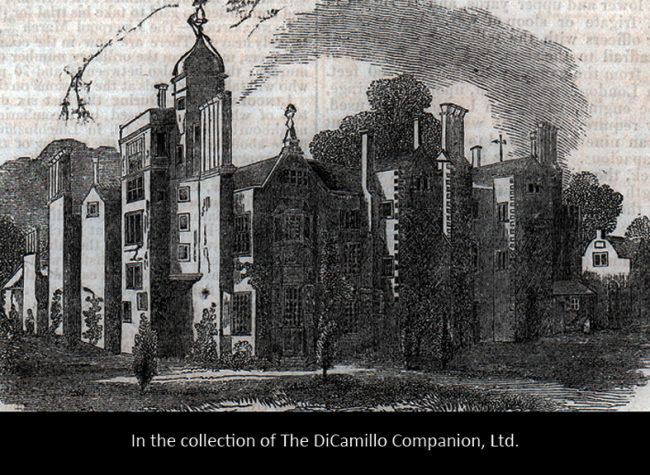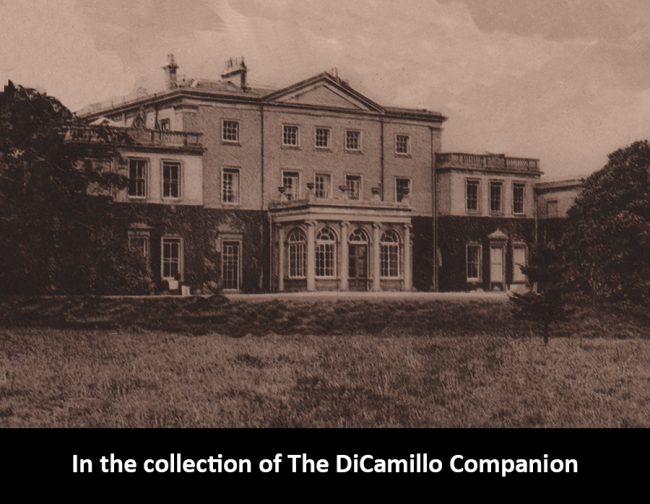
The second House (demolished) from an 1843 issue of "The Illustrated London News"

The current (third) house from a circa 1922 postcard
Earlier Houses: There was a medieval timber-framed manor house (the first house) that was replaced by John Abington in the 16th century with a brick house with towers and large windows (the second house, illustration of which in the "Images" section). The second house was demolished and replaced in the 19th century by the current (third) house (see photo in "Images" section).
House & Family History: John Abington (sometimes spelled Habington) was an official in the court of Queen Elizabeth I and, notably, a Catholic Recusant, which would cause much trouble for his children. After John's death in 1582, his sons, Edward and Thomas Abington, were involved in the Babington Plot (the 1586 plan to assassinate Queen Elizabeth, a Protestant, and to put Mary, Queen of Scots, a Catholic, on the English throne) and the Gunpowder Plot of 1605, a failed assassination attempt against King James I by a group of provincial English Catholics. After the discovery of their complicity in the plots Edward was beheaded, while Thomas was shown mercy because of his youth. After his release from prison, Thomas and his wife Mary returned to Hindlip Hall, which they adapted as a Catholic refuge, with priest holes constructed for hiding Catholic clerics. Hindlip was searched on January 20, 1606, but no one was discovered; however, the House continued to be searched for the next 12 days. A document written at the time records that the searchers "found two cunning and very artificial conveyances in the main brick-wall, so ingeniously framed, and with such art, as it cost much labour ere they could be found. Three other secret places, contrived with no less skill and industry, were found in and about the chimneys, in one whereof two of the traitors were close concealed. These chimney-conveyances being so strangely formed, having the entrances into them so curiously covered over with brick, mortared and made fast to planks of wood, and colored black, like the other parts of the chimney, that very diligent inquisition might well have passed by, without throwing the least suspicion upon such unsuspicious places." Ultimately, 11 hiding places were discovered, four of which sheltered Catholics, all of whom were eventually executed. Thomas's son, William Abington, was a minor poet; his son, also Thomas, died without an heir and left the Hindlip Estate to Sir William Compton. The 16th century house was destroyed by fire in 1820 and was immediately replaced by a new house, built by Viscount Southwell, in the Greek Revival style. After Lord Southwell's death in 1860 Hindlip was purchased by the Burton-on-Trent brewer Henry Allsopp (elevated to the peerage as the 1st Baron Hindlip in 1886). The Allsopp family moved their seat to Wiltshire early in the 20th century, after which Hindlip Hall went through a number of uses, including approximately 25 years as a girls' school. During World War II Hindlip was taken over by the Ministry of Works. In his 2015 book, "The King's Private Army: Protecting the British Royal Family during the Second World War," Andrew Stewart revealed that, according a 1940 plan to be implemented if a German invasion of Britain took place, the royal family was to be evacuated to Madresfield Court, the prime minister's office would move to Spetchley Park, and the cabinet would be installed at Hindlip Hall, all three houses located near each other in Worcestershire. In 1947 Worcestershire County Council purchased the Hindlip Estate; the land was set aside for future use as a college, while the House was converted into the headquarters for the West Mercia Police, a use which it continues to serve today.
Garden & Outbuildings: In 1887 the 2nd Lord Hindlip created a new six-acre lake in the grounds.
Title: Burke's & Savills Guide to Country Houses, Volume II: Herefordshire, Shropshire, Warwickshire, Worcestershire
Author: Reid, Peter
Year Published: 1980
Publisher: London: Burke's Peerage
ISBN: 0850110319
Book Type: Hardback
House Listed: Grade II*
Park Listed: Not Listed
Past Seat / Home of: SEATED AT 16TH CENTURY (SECOND) HOUSE: John Abington (Habington), late 16th century; William Abington (Habington), 17th century. Sir William Compton, 17th century. SEATED AT 19TH CENTURY (THIRD) HOUSE: Thomas Anthony Southwell, 3rd Viscount Southwell, early 19th century. Henry Allsopp, 1st Baron Hindlip, late 19th century; Allsopp family here 1860 until the early 20th century.
Current Ownership Type: Government
Primary Current Ownership Use: Other
Ownership Details: Since 1967 West Mercia Police headquarters
House Open to Public: No
Phone: 03003-333-000
Website: http://www.westmercia.police.uk
Historic Houses Member: No